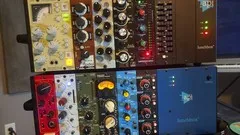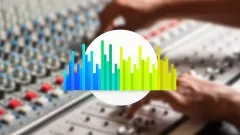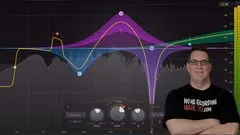
Audio Engineering: All About EQ 
Learn all about EQ in this comprehensive audio engineering course. EQ is a powerful tool that allows you to alter the frequency of a track, instrument, or vocal. Discover how to pinpoint problem frequencies and confidently adjust them with practice. Understand the difference between parametric and semi-parametric EQs, as well as fixed frequency EQs. Explore various EQ curves and curve types, including asymmetrical, symmetrical, proportional, tilt, and Baxandall. Dive into dynamic EQs and learn how to use a Pultec style EQ, a unique and highly sought-after tool. Master the art of EQing vocals with expert guidance. Don't miss out on this opportunity to enhance your audio engineering skills. Get a comprehesive understanding of Audio Engineering: All About EQ which is a pay course. AZ Class provides this course data for free. Learn more certificate and details here. ▼
ADVERTISEMENT
Course Feature
![]() Cost:
Cost:
Paid
![]() Provider:
Provider:
Udemy
![]() Certificate:
Certificate:
Paid Certification
![]() Language:
Language:
English
![]() Start Date:
Start Date:
2015-12-20
Course Overview
❗The content presented here is sourced directly from Udemy platform. For comprehensive course details, including enrollment information, simply click on the 'Go to class' link on our website.
Updated in [October 16th, 2023]
What does this course tell?
(Please note that the following overview content is from the original platform)
EQ is one of the two most commonly used signal processing tools audio engineers use everyday the other being a compressor EQ is very powerful because allows to alter the frequency of a track instrument or vocal Anyone interested in learning more about EQ should subscribe to this course In this course I start with learning frequencies Its incredible how some engineers can pinpoint problem frequencies I will show my approach for learning frequencies when you hear them After a lot of practice you will be grabbing an EQ and adjusting problem frequencies with confidenceYou will also learn the difference in parametric and semi parametric EQs Also I go over fixed frequency eqs Knowing the difference between these will help you know which ones to reach for and when EQ curves can take on many different settings with its different shapes of curves In this course I go over the different settings listed belowHigh pass filter& Low cutLow pass filter& High cutpeakingLow shelfHigh shelfBand passThe way an EQ boost and cuts can have unique shape of its own In this course I go over the following curve typesAsymmetricalSymmetricalProportionalTiltBaxandallI also cover the different EQ types such as a dynamic EQ I will go over how to use a Pultec style EQ This the most awkward EQs you will come across because of its unique design and labeling After the learning how to use a pultec eq and hearing what it can do its no surprise why this type of EQ in heavily emulated as plugins and recreated as hardware In course I will go over my approach for Eqing a vocal Vocals can one of the hardest things to eq because every vocal is different Prepare to spend more than an hour with me as I tech you all about EQ
We considered the value of this course from many aspects, and finally summarized it for you from two aspects: skills and knowledge, and the people who benefit from it:
(Please note that our content is optimized through artificial intelligence tools and carefully reviewed by our editorial staff.)
What skills and knowledge will you acquire during this course?
During this course on Audio Engineering: All About EQ, learners will acquire the following skills and knowledge:
1. Understanding frequencies: The course starts by teaching learners about frequencies and how to identify problem frequencies in audio tracks, instruments, or vocals.
2. Adjusting problem frequencies: Through practice and guidance, learners will gain confidence in using an EQ to adjust problem frequencies effectively.
3. Different types of EQs: Learners will learn about parametric and semi-parametric EQs, as well as fixed frequency EQs. Understanding the differences between these types will help learners choose the appropriate EQ for specific situations.
4. EQ curves: The course covers various EQ curve settings, including high pass filter & low cut, low pass filter & high cut, peaking, low shelf, high shelf, and band pass. Each of these settings has its own unique shape of curves.
5. Curve types: Learners will be introduced to different curve types, such as asymmetrical, symmetrical, proportional, tilt, and Baxandall. Understanding these curve types will enable learners to achieve specific EQ boosts and cuts.
6. Dynamic EQ: The course covers the concept and usage of dynamic EQ, which allows for dynamic adjustments based on the audio signal's characteristics.
7. Pultec style EQ: Learners will learn how to use a Pultec style EQ, which has a unique design and labeling. This EQ type is heavily emulated as plugins and recreated as hardware due to its effectiveness.
8. EQing vocals: The course provides an in-depth approach to EQing vocals, which can be challenging due to the individual characteristics of each vocal. Learners will spend ample time with the instructor to learn various techniques and strategies.
By the end of this course, learners will have acquired the necessary skills and knowledge to effectively use EQ in audio engineering, enabling them to enhance the quality and balance of audio tracks, instruments, and vocals.
Who will benefit from this course?
This course on Audio Engineering: All About EQ will benefit individuals interested in learning more about EQ and its applications in audio engineering. Specifically, the course will be beneficial for:
1. Audio Engineers: This course is designed for audio engineers who use EQ as one of their primary signal processing tools. It will enhance their understanding of frequencies, problem identification, and adjustment techniques, allowing them to confidently use EQ to improve the quality of tracks, instruments, and vocals.
2. Music Producers: Producers involved in music production can benefit from this course as it provides insights into EQ techniques that can enhance the overall sound and balance of a track. Understanding different EQ types and curve shapes will enable producers to shape the tonal characteristics of individual elements within a mix.
3. Sound Designers: Sound designers working in various fields such as film, television, and gaming can gain valuable knowledge from this course. EQ is crucial in shaping the sonic characteristics of sound effects and creating a balanced mix. Learning about different EQ types and curve shapes will allow sound designers to achieve desired tonal qualities and effectively blend sounds together.
4. Mixing Engineers: Mixing engineers responsible for balancing and blending multiple audio tracks will find this course beneficial. Understanding frequencies, problem identification, and adjustment techniques will enable them to address any issues in the mix and achieve a more cohesive and polished sound.
5. Home Studio Owners: Individuals who have their own home studios and are passionate about recording and producing music can benefit from this course. Learning about EQ techniques will help them improve the quality of their recordings and achieve a more professional sound.
Course Syllabus
Introduction
Differences types of EQ's
DIfferent Curves in EQ's
How to use a Pultec EQ
EQ techniques and Tips
Conclusion
Course Provider

Provider Udemy's Stats at AZClass
Discussion and Reviews
0.0 (Based on 0 reviews)
Explore Similar Online Courses

Make Memes And Gain Virality: A Complete Guide

House Dance Masterclass How To Street Dance Tutorial

Python for Informatics: Exploring Information

Social Network Analysis

Introduction to Systematic Review and Meta-Analysis

The Analytics Edge

DCO042 - Python For Informatics

Causal Diagrams: Draw Your Assumptions Before Your Conclusions

Whole genome sequencing of bacterial genomes - tools and applications

Audio Equalization (EQ) Techniques and Tips

EQ Essentials: Ultimate Guide to Using Equalization in Music


Start your review of Audio Engineering: All About EQ